Budget Micro-ATX P55 Faceoff: Gigabyte GA-P55M-UD2 and ASRock P55M Pro
by Gary Key on October 5, 2009 12:30 PM EST- Posted in
- Motherboards
Networking
The Windows 2000 Driver Development Kit (DDK) includes a useful LAN testing utility called NTttcp. We used the NTttcp tool to test Ethernet throughput and the CPU utilization of the various Ethernet Controllers used on the Intel motherboards. We set up one machine as the server; in this test, an Intel system with an Intel CSA Gigabit LAN connection. Intel CSA has a reputation for providing fast throughput and is a logical choice for our Gigabit LAN server.
On the server side, we used the following Command Line as suggested by the VIA whitepaper on LAN testing:
Ntttcpr -m 4,0,‹server IP› -a 4 -l 256000 -n 30000
On the client side (the motherboard under test), we used the following Command Line:
Ntttcps -m 4,0,‹client IP› -a 4 -l 256000 -n 30000
At the conclusion of the test, we captured the throughput and CPU utilization figures from the client screen.

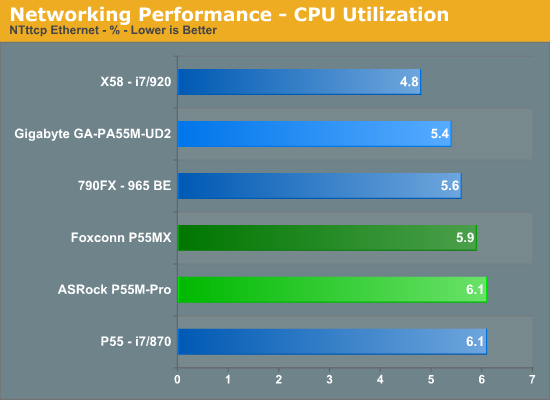
Our network throughput test indicates how well a particular controller design from Realtek, Marvell, or Intel performs instead of being indicative of true chipset performance. This also holds true for the CPU utilization results, though this test can also be influenced to certain degree by the BIOS code and chipset interconnect design.
The CPU utilization and throughput numbers favor the Realtek controller on the Gigabyte board, followed closely by the same Realtek chipset on the Foxconn and ASRock boards. In practice, few if any users will notice a difference, even if they have the requisite gigabit hub, as storage performance frequently bottlenecks the actual transfer rates.
For our second series of networking tests we utilize a Promise SmartStor NS4600 NAS unit equipped with two WD Caviar Black 640GB drives in RAID 1 operation. We are using two benchmarks from Intel’s popular NASPT 1.70 testing tool. The Promise NAS unit is connected to each test platform via a NetGear Gigabit Ethernet switch. We left all settings at their defaults on both the motherboard and Promise NAS unit. Our was to maximize the performance of the NAS unit to verify our network throughput capabilities on each motherboard.


Our three P55 test subjects perform almost identically in our actual usage tests.
USB / FireWire Performance
Our USB transfer speed tests are conducted with an USB 2.0/FireWire based Lacie external hard drive unit featuring a 1TB 7200rpm Samsung drive . In the SSD to External test, we transfer a 3.82GB folder containing 2735 files of various sizes from our Kingston 80GB SSD to the Lacie drive. In the next two file tests, we use the same 3.82GB folder to transfer from our WD VRaptor 300GB hard drive to the external Lacie drive utilizing the USB 2.0 and IEEE 1394a interface.
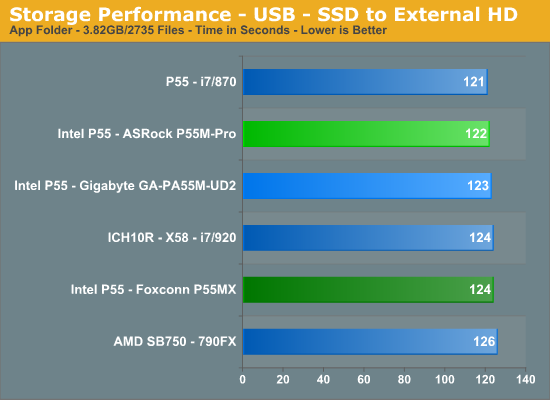
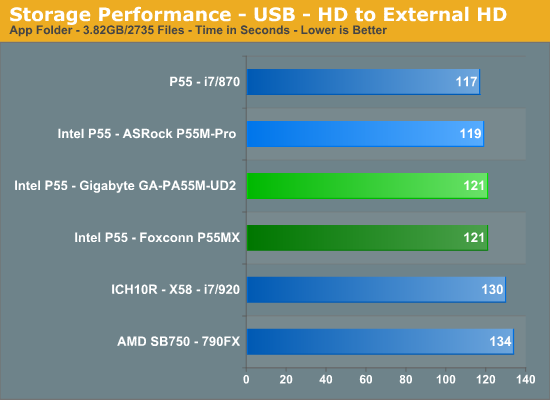
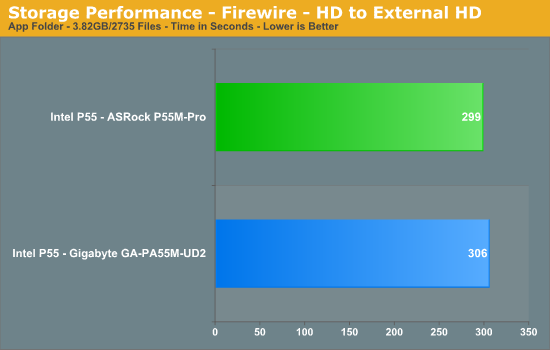
The ASRock board slightly outperforms the Gigabyte board in our USB transfer tests. The VIA Firewire controller on the ASRock board has a slightly higher write speed (+3Mb/s) under HDTach/HDTune and it shows up in our file transfer test.
Storage Performance
In our storage test, we utilize the same 3.82GB test folder and transfer it from our WD VRaptor drive to our Kingston 80GB SSD.
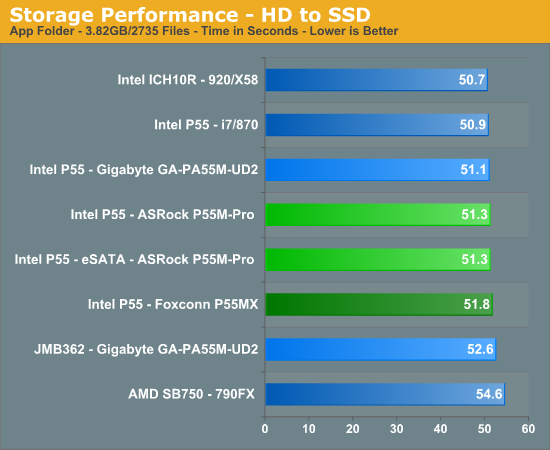
Once again, our P55 motherboards perform almost identically. The P55 chipset on the Gigabyte board has a 3% advantage over the JMicron controller on the same board. However, any measurable differences were not recognized in actual usage.










55 Comments
View All Comments
goinginstyle - Monday, October 5, 2009 - link
I loved the review also and it showed a lot of work went into testing these boards. I just wonder when TA152H is going to ruin this thread but until then it nice to see constructive posts. I also wish the mobo guys would just drop the floppy and IDE ports when possible. It would free up board real estate and hopefully drop the cost a little more.papapapapapapapababy - Monday, October 5, 2009 - link
not touching any of this at least it has Socket 775 mounting holesusb3 @ pci3 @sata6 and im there.
Docket - Monday, October 5, 2009 - link
It is a shame that there are no Linux versions of the Gigabyte software reviewed here... oh well maybe some day in a distant future.mitt - Monday, October 5, 2009 - link
Hallelujah! DPC latency benchmark in AnandTech reviews!mathew7 - Monday, October 5, 2009 - link
When MB manufacturers are going to let go of PCI?I recently switched to Micro-ATX, and found I have a real problem of choosing a motherboard.
I'm looking at buying a PCIe X-Fi, but would like to use a dual-slotted video card. But I would like to keep my options open for a second card (I'm htinking about physics, not SLI/CF, so dual-slot cooling is not required). While the Gigabyte does not pass my requirements, the Asrock also has a problem: usage of a dual-slot-cooled card inhibits the usage of the PCIex1 slot.
I intend to switch to i5/P55 at the start of next year, so I'm watching closely.
Jaybus - Thursday, October 8, 2009 - link
That will be a slow transition. There are still a lot of PCI adapters being sold out there, especially for some specialty markets like scientific instrumentation that take time to transition to new interfaces due to cost and low volume. Nevertheless, the demise of PCI is starting to happen. For most people it's not a big deal, because they only need 1 or 2 PCIe x16 slots for graphics cards and will never use the rest of the slots anyway.MadMan007 - Monday, October 5, 2009 - link
Kind of funny but Intel is leading the pack in that specific area, their $200 (ugh) 'Extreme' DP55SB mATX P55 mobo has no PCI slots, also no PS/2, IDE or floppy. Maybe it's consistent since they ditched PS/2 and other legacy connectors on some boards a while back. No telling on the overclocking front but it is an 'extreme' board so it may have at elast some overclocking features. It has a couple of neat features actually, Bluetooth and Intel NIC.Jaybus - Thursday, October 8, 2009 - link
And uATX is a good platform to remove PCI from. Why not drop it from uATX? They can always leave it on ATX boards for a while for those who absolutely need PCI slots. I think other manufacturers will follow that path very soon.MadMan007 - Monday, October 5, 2009 - link
*bzzt* The only PCIe 2.0 lanes on a P55 platform are from the CPU. So look carefully at specs and double check with companies when they say their secondary slots, especially ones that aren't even 16x mechanical, are PCIe 2.0. The UD2's 4x electrical slot in particular is clearly not according to Gigabyte, the ASRock claims to be but I'm not sure how if all 16 CPU PCIe 2.0 lanes are used for the graphics slot. If they used a lane splitter to provide PCIe 2.0 lanes to the other slots it kind of defeats the purpose, and if so it would be good to check performance with those slots populated.MadMan007 - Monday, October 5, 2009 - link
To follow up on this, the comment was based on the first few paragraphs. I looked over Intel's manual for their 'extreme' mATX board for my post about it and Intel actually states their mobo has PCIe 2.0 lanes to the additional PCIe slots. Not surprising for the 8x slot I guess but it is for the 1x slots and it seems unlikely Intel would misquote specs.On a related note there is one thing I've not seen yet from any review and that is how PCIe lanes get assigned, mainly to the primary 16x slot, when populating a secondary PCIe slot with a 1x or 4x card. Do the lane splitter chips assign 8x lanes to a secondary slot which has a 1x or 4x card or what? Not a huge deal but it's a little thing that would be nice to know.